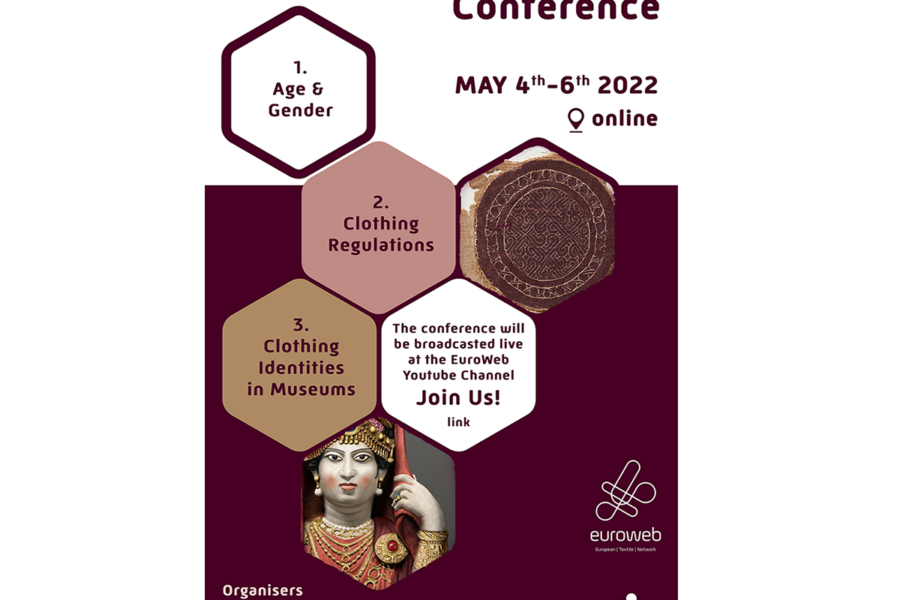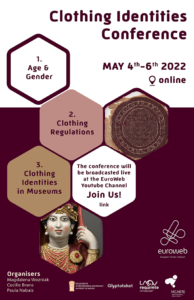
Clothing Identities Conference – Programme Available!
We are happy to announce that the full programme for the Clothing Identities Conference, which will take place between the 4th and the 6th of May 2022, is now available. You can check the full schedule, the abstracts for the presentations as well as details on how to follow the Conference in the Book of Abstracts.
This three-day conference will take place online to ensure that as many colleagues as possible will be able to participate. The conference is organised by Magdalena Wozniak (University of Warsaw), Paula Nabais (NOVA University of Lisbon), and Cecilie Brøns (Ny Carlsberg Glyptotek, Copenhagen).
With clothing, humans express aspects of identity such as their gender, age, beliefs, and social status. Ancient costumes combine skin and textile, wrapping and tailoring. Many clothing elements in antiquity are unisex but are worn differently according to gender and age.
Children’s clothes are generally simple, but Roman children, for example, expressed their civil status and gender through clothing. Adults negotiate the changes in their age, body and status through garments. Poor people, slaves, and workers performing hard physical work, wear loose-fitting garments allowing freedom of movement and Late Antique sources report on second-hand clothing as an important part of the economy. Members of the elite, on the other hand, display their wealth through luxurious garments, decorated with complex patterns including precious metals and stones as well as precious dyes.
A legal framework of sumptuary laws and prohibitions, and a normative framework of appropriate dress, accompany dress history for at least 2500 years. Fashionable items are generated from innovations and trade, and they have the capacity to alter body perceptions and gendered features of dress.
The objective of this conference is to bring together experts from various disciplines and working on diverse chronological periods (from Prehistory to the 21st century) and geographical areas to address the question of clothing as an expression of identity.
The conference is divided in three main themes:
1) Age and gender
The use of textiles and dress to express aspects of identity, particularly age and gender, as part of non-verbal communication systems. How do gender and age through clothing express one’s place in the economic, social, and productive spheres in ancient and historical societies?
2) Clothing identities in museums
The existence of legal and normative frameworks, sumptuary laws and religious prescriptions aimed at regulating dress. How and to which extent did sumptuary laws and prohibitions shape ancient and historical clothing?
3) Clothing regulations in sumptuary and religious dress.
How can we rethink and re-make dress exhibitions in museums in a more inclusive way, and discuss their colonial, ethnic, nationalistic, and religious markers and symbolism? We also welcome papers presenting various dissemination strategies to prompt interaction between textile collections in museums and the public.
The conference will take place online, via Zoom. The access link will be sent to the speakers via e-mail prior to the conference to all speakers. Please access the link, at least 5 minutes prior to the beginning of the sessions.
All speakers will have 20 minutes allocated for their presentations followed by 10 minutes for discussion. The organisers kindly ask the speakers to keep their scheduled time, to avoid any delays.
The conference will be broadcasted via Youtube. The audience can follow the conference live at the EuroWeb Youtube Channel.
The programme is set for the timezone GMT +1h / UTC +1h. Please check your timezone and adjust accordingly.
Any questions should be addressed to: eurowebwg2@gmail.com

We are happy to announce that the full programme for the Clothing Identities Conference, which will take place between the 4th and the 6th of May 2022, is now available. You can check the full schedule, the abstracts for the presentations as well as details on how to follow the Conference in the Book of Abstracts.
This three-day conference will take place online to ensure that as many colleagues as possible will be able to participate. The conference is organised by Magdalena Wozniak (University of Warsaw), Paula Nabais (NOVA University of Lisbon), and Cecilie Brøns (Ny Carlsberg Glyptotek, Copenhagen).
With clothing, humans express aspects of identity such as their gender, age, beliefs, and social status. Ancient costumes combine skin and textile, wrapping and tailoring. Many clothing elements in antiquity are unisex but are worn differently according to gender and age.
Children’s clothes are generally simple, but Roman children, for example, expressed their civil status and gender through clothing. Adults negotiate the changes in their age, body and status through garments. Poor people, slaves, and workers performing hard physical work, wear loose-fitting garments allowing freedom of movement and Late Antique sources report on second-hand clothing as an important part of the economy. Members of the elite, on the other hand, display their wealth through luxurious garments, decorated with complex patterns including precious metals and stones as well as precious dyes.
A legal framework of sumptuary laws and prohibitions, and a normative framework of appropriate dress, accompany dress history for at least 2500 years. Fashionable items are generated from innovations and trade, and they have the capacity to alter body perceptions and gendered features of dress.
The objective of this conference is to bring together experts from various disciplines and working on diverse chronological periods (from Prehistory to the 21st century) and geographical areas to address the question of clothing as an expression of identity.
The conference is divided in three main themes:
1) Age and gender
The use of textiles and dress to express aspects of identity, particularly age and gender, as part of non-verbal communication systems. How do gender and age through clothing express one’s place in the economic, social, and productive spheres in ancient and historical societies?
2) Clothing identities in museums
The existence of legal and normative frameworks, sumptuary laws and religious prescriptions aimed at regulating dress. How and to which extent did sumptuary laws and prohibitions shape ancient and historical clothing?
3) Clothing regulations in sumptuary and religious dress.
How can we rethink and re-make dress exhibitions in museums in a more inclusive way, and discuss their colonial, ethnic, nationalistic, and religious markers and symbolism? We also welcome papers presenting various dissemination strategies to prompt interaction between textile collections in museums and the public.
The conference will take place online, via Zoom. The access link will be sent to the speakers via e-mail prior to the conference to all speakers. Please access the link, at least 5 minutes prior to the beginning of the sessions.
All speakers will have 20 minutes allocated for their presentations followed by 10 minutes for discussion. The organisers kindly ask the speakers to keep their scheduled time, to avoid any delays.
The conference will be broadcasted via Youtube. The audience can follow the conference live at the EuroWeb Youtube Channel.
The programme is set for the timezone GMT +1h / UTC +1h. Please check your timezone and adjust accordingly.
Any questions should be addressed to: eurowebwg2@gmail.com
